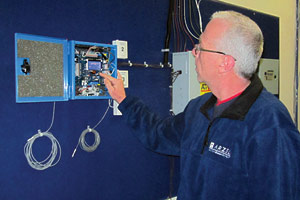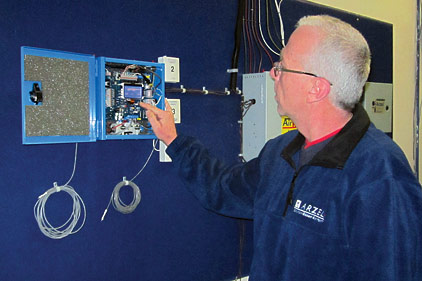
|
| Mike Fedor, tech support, Arzel Zoning, looks at one of the company’s panels. Zoning manufacturers say adding zoning to a business can help increase profitability. |
Zoning is no longer an anomaly, and manufacturers are making sure that contractors are aware of the many benefits it offers.
According to Dick Foster, president, Zonefirst, apathy is the biggest challenge facing his company right now.
“Contractors are complacent about zoning and the typical response is, ‘If someone asks me for zoning, we’ll offer it,’” Foster said. “Even with more players in the zoning market, zoning is still a very small percentage of the market. Contractors are still focused on the box and do not take a system approach. If they were, they’d be selling more air cleaners, humidifiers, and ventilation and zoning units. Most contractors are order takers and wait for the phone to ring to fix what is broken versus proactively selling systems.”
That’s why zoning manufacturers are taking the initiative to make zoning an attractive option for contractors.
Ken Barton, technical support/sales, Arzel Zoning Technology Inc., said his company is committed to educating contractors.
“By making contractors more comfortable in their knowledge of zoning, airflow, static pressure, and when to use bypass, we can make them more confident that what they are selling is something that will work, not harm the equipment, and deliver what they have promised customers,” Barton said.
Foster also said education is a key component in making zoning more attractive to contractors. He said one of the big things zoning manufacturers need to do is show contractors zoning is not as hard as they think.
“According to North American Technician Excellence (NATE), the sections of tests with the lowest scores are airflow and low-voltage controls,” Foster said. “Unfortunately for zoning, these are the two key skill sets contractors need to understand to install zoning.”
Kyle Golden, product manager of controls, Lennox Intl. Inc., said its iHarmony Zoning System was developed with the installer in mind. He said contractors should offer zoning because it’s great for customers.
“We know that zoning installations can be complex and time-consuming,” Golden said. “It can be so difficult to get the system set up right the first time. This causes many dealers to build in multiple callbacks for zoning installations. With iHarmony, we simplified the entire setup and configuration process. Everything the technician needs to set up an iHarmony Zoning System is displayed on the easy-to-use Lennox iComfort Wi-Fi thermostat. Technicians can configure the heating, cooling, and blower cfm; see how much cfm is available for the system; see how much is assigned for each zone; and start or stop testing all on one screen. This enables the technician to set up the system in a matter of minutes and helps avoid callbacks.”
Reducing callbacks is also a focus of the staff at Honeywell. Kevin Graebel, indoor air and water quality leader, said the company is constantly looking for ways to provide solutions to make contractors more profitable on the job.
“Honeywell continues to develop innovative solutions that improve the installation process to make it faster and reduce callbacks,” Graebel said. “Last year, we released the TrueZONE Bypass Damper, which dramatically simplifies the setup and provides much more consistent performance compared to the old, weighted, arm-style bypass damper. Since launch, two-thirds of our customers have migrated to this new solution and feedback has been incredible.”
Thomas Jackson, CEO, Jackson Systems LLC, said offering zoning can be a highly profitable option for contractors, which can provide a competitive edge over nearby contractors who don’t offer it. He noted his company provides a wide selection of dampers and prides itself on its zoning panels being easy to install.
“Our Barometric Zone Damper eliminates the need to install a bypass damper,” Jackson said. “This has become an extremely popular product for contractors as some states are passing legislation to limit the use of bypass. Additionally, many retrofit installations do not allow room for a bypass damper. Our two-zone and three-zone panels are preconfigured for the particular application. All panels are double-fused to protect the panel and HVAC equipment and the wiring diagram is inside of each panel cover, so there is no need to locate an installation manual.”
Mike Smith, senior product marketing manager, commercial products, Mitsubishi Electric US Cooling & Heating Division, said too many homeowners are unaware that true zoning capabilities exist. Mitsubishi Electric is taking zoning a step further by offering it through its ductless zoning systems.
“The challenge moving forward is to continue educating homeowners on the benefits of zoning and how ductless systems maximize those benefits,” Smith said. “HVAC contractors are the best messengers for relaying these benefits to homeowners.”
Going forward, Graebel insists the industry must do everything it can to educate prospective users and installers of zoning’s many benefits.
“Lack of education, by both the homeowner and contractor, is the biggest issue currently facing zoning,” Graebel said. “Many contractors are hesitant to offer the solution because of bad experiences they have had in the past. They fear they will lose money if they have to make multiple trips to the home to ensure the system is running properly. They’re also concerned that they may have to tear down walls or run new wires up to the thermostats.
“When talking about the homeowner side, there is growing awareness for the solution, but, in many cases, they don’t know to ask their contractor out of fear it would be too expensive to install.”
Jackson said customer education remains a forefront issue as many homeowners don’t understand the benefits when it comes to comfort and energy savings of having a zoned home.
That sentiment was echoed by Golden, who said contractors should offer zoning because, in the end, it will be great for customers.
“Homeowners wouldn’t be happy if they were unable to turn the lights off in an unoccupied room or if the lights failed to adequately illuminate certain spaces,” Golden said. “HVAC systems account for a much greater portion of residential electricity use than lighting, and as the average home size continues to increase, problems like wasted energy from heating or cooling unused rooms and discomfort from hot or cold spots is becoming more common. Homeowners aren’t happy with the increase in cost and may not realize that anything can be done about it. With zoning, contractors can offer the perfect solution to these and other problems. Offering a zoning solution can serve to differentiate contractors from those in their area who do not have the expertise to do so. And upselling zoning on a system replacement call is a great way to add to the bottom line.”
Publication date: 5/19/2014
Want more HVAC industry news and information? Join The NEWS on Facebook, Twitter, and LinkedIn today!



Report Abusive Comment